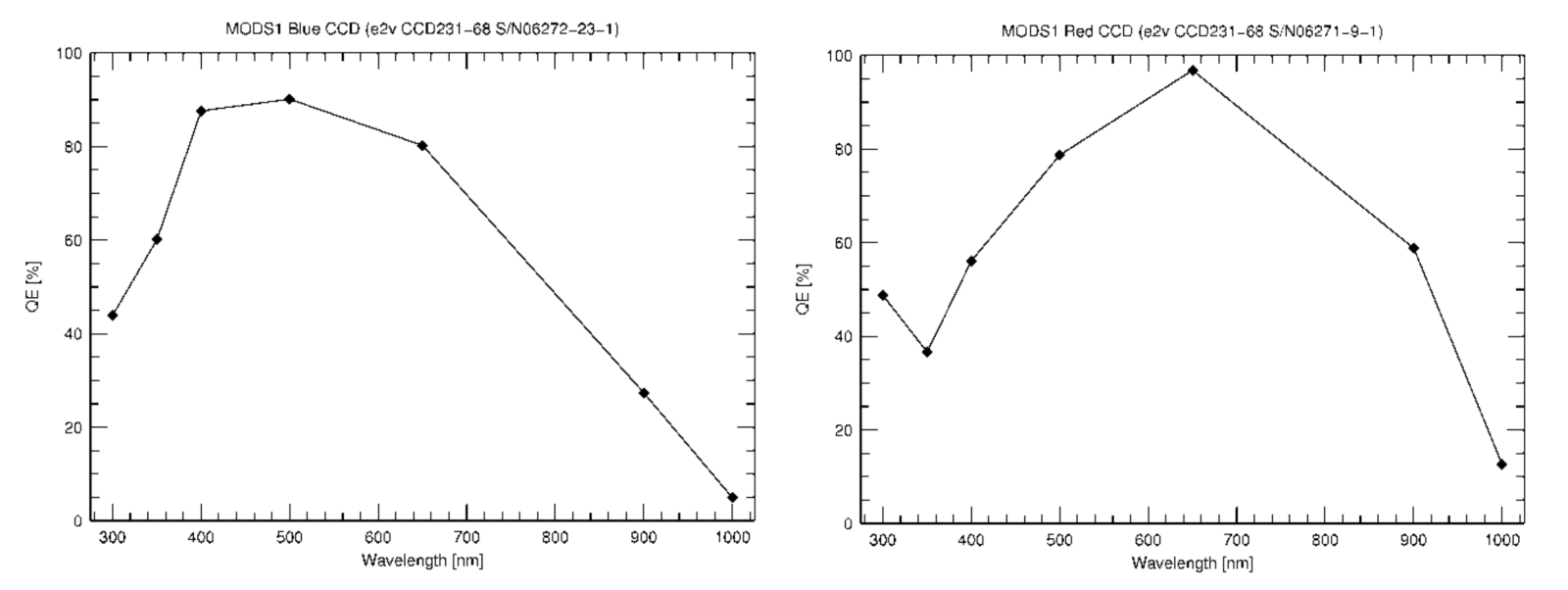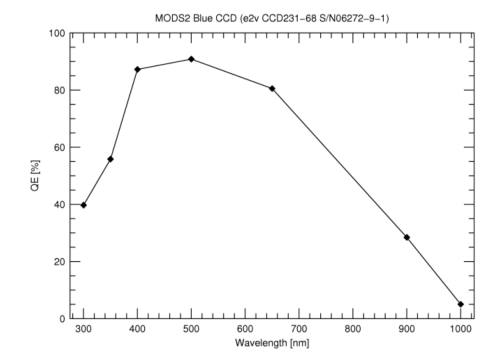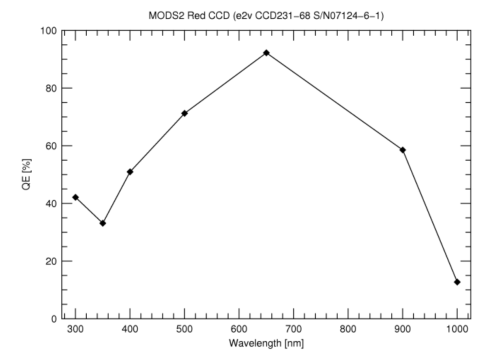Detector
The basic properties of the CCDs measured at operating temperature (~ -100°C) are summarized in the below table. The conversion gain, readout noise, linearity, and dark current are average values for the four quadrants, measured on-telescope under normal operating conditions. Each quadrant is read through two output chains (even and odd), each of which have slightly different gain and DC bias levels. This makes the four quadrants distinct in raw images, and on close examination there is visible even/odd vertical striping due to the two-channel readout per quadrant. The modsCCDRed scripts were designed to remove the effects of this even/odd striping and quadrant-to-quadrant level differences.
CCD Regions of Interest
The MODS’s CCDs are rectangular: 8288 pixels wide by 3088 pixels high. The number of pixels readout depends on the instrument mode: 8K×3K (full-frame) for grating spectra, 4K×3K for prism spectra, 3K×3K (actually ~2900×2900) for imaging mode and MOS target acquisition, and 1K×1K for long-slit target acquisition. The primary readout modes can be visualized as follows:
Binning
All of the MODS CCDs may be binned by a factor of 2 in both columns and rows. But binning along the dispersion axis is strongly discouraged since it tends to produce pronounced electronic artifacts along rows or segments of rows. Some examples are shown on the Image Artifacts and Features page. For programs requiring a high cadence series of observations, binning along only the spatial, but not the dispersion axis (1×2 binning, ccdbin 1 2), is a compromise which will reduce overheads but not produce electronic artifacts. Read+write overheads are reduced by a factor one-third for 1×2 binned data, and a factor one-half for 2×2 binning as compared to unbinned (1×1) data. Read+write overheads for unbinned and 2×2 binning on each of the 4 MODS detectors are tabulated in the section on Overheads.
MODS1 Detector Overview
| BLUE | RED | |
|---|---|---|
| Science CCDs | e2v CCD231-68 3072×8196 (15um pixels) Std Silicon + Astro-Broadband coating |
e2v CCD231-68 3072×8196 (15um pixels) 40um Deep-Depletion Silicon + Astro-ER1 coating |
| Field of View | ~6.0×6.0 arcmin (~2900×2900 pixels) | ~6.0×6.0 arcmin (~2900×2900 pixels) |
| Focal Plane Scale | 1.667 arcsec/mm | 1.667 arcsec/mm |
| Measured Image Quality (80%EE) | Blue Camera (400nm): 0.25-arcsec inner 2-arcmin (best focus) 0.43-arcsec inner 4-arcmin 0.55-arcsec 6-arcmin |
Red Camera (700nm): 0.29-arcsec inner 2-arcmin (best focus) 0.41-arcsec inner 4-arcmin 0.51-arcsec 6-arcmin |
| Imaging Pixel Scale | 0.120 arcsec/pixel | 0.123 arcsec/pixel |
| ADC Saturation (ADU) | 65535 | 65535 |
| Pixel Full Well | 200,000e–/gain (~80,000 ADU) | 200,000e–/gain (~80,000 ADU) |
| Typical CTE | 99.9995% | 99.9995% |
| Conversion Gain (e–/ADU) | 2.1 | 2.5 |
| Readout Noise (e–) | 3.0 | 4.2 |
| Linearity | <1% @ 55K ADU | <1% @ 52K ADU |
| Dark Current (e–/pixel/hr) | 0.5±0.2 | 0.4±0.1 |
+ The gain and readnoise were determined from data taken on 2016-Nov-09.

| Wavelength (nm) | QE (%) | |
|---|---|---|
| MODS1 BLUE | MODS1 RED | |
| 300 | 43.9 | 48.7 |
| 350 | 60.1 | 36.6 |
| 400 | 87.6 | 56.1 |
| 500 | 90.1 | 78.7 |
| 650 | 80.2 | 96.8 |
| 900 | 27.3 | 58.8 |
| 1000 | 4.9 | 12.6 |
MODS2 Detector Overview
| BLUE | RED | |
|---|---|---|
| Science CCDs | e2v CCD231-68 3072×8196 (15um pixels) Std Silicon + Astro-Broadband coating |
e2v CCD231-68 3072×8196 (15um pixels) 40um Deep-Depletion Silicon + Astro-ER1 coating |
| Field of View | ~6.0×6.0 arcmin (~2900×2900 pixels) | ~6.0×6.0 arcmin (~2900×2900 pixels) |
| Focal Plane Scale | 1.667 arcsec/mm | 1.667 arcsec/mm |
| Measured Image Quality (80%EE) | Blue Camera (400nm): 0.25-arcsec inner 2-arcmin (best focus) 0.43-arcsec inner 4-arcmin 0.55-arcsec 6-arcmin |
Red Camera (700nm): 0.29-arcsec inner 2-arcmin (best focus) 0.41-arcsec inner 4-arcmin 0.51-arcsec 6-arcmin |
| Imaging Pixel Scale | 0.120 arcsec/pixel | 0.123 arcsec/pixel |
| ADC Saturation (ADU) | 65535 | 65535 |
| Pixel Full Well | 200,000e–/gain (~80,000 ADU) | 200,000e–/gain (~80,000 ADU) |
| Typical CTE | 99.9995% | 99.9995% |
| Conversion Gain (e–/ADU) | 2.0 | 1.7 |
| Readout Noise (e–) | 3.7 | 2.8 |
| Linearity | <1% @ 55K ADU | <1% @ 52K ADU |
| Dark Current (e–/pixel/hr) | 0.5±0.2 | 0.4±0.1 |
+ The gain and readnoise were determined from data taken on 2016-Nov-09.
| Channel | Quadrant | Conversion Gain (e–/ADU) | Readout Noise (e–) |
|---|---|---|---|
| Blue | Q1 | 1.99 | 3.66 |
| Q2 | 2.06 | 3.62 | |
| Q3 | 1.96 | 3.72 | |
| Q4 | 2.01 | 3.64 | |
| Red | Q1 | 1.70 | 2.95 |
| Q2 | 1.67 | 2.65 | |
| Q3 | 1.66 | 2.78 | |
| Q4 | 1.66 | 2.87 |
+ The gain and readnoise were determined from data taken on 2016-Nov-09.
MODS2 Quantum Efficiency are shown below:
| Wavelength (nm) | QE (%) | |
|---|---|---|
| MODS2 BLUE | MODS2 RED | |
| 300 | 39.7 | 42.1 |
| 350 | 55.8 | 33.1 |
| 400 | 87.2 | 50.9 |
| 500 | 90.8 | 71.2 |
| 650 | 80.5 | 92.2 |
| 900 | 28.4 | 58.5 |
| 1000 | 5.0 | 12.7 |




